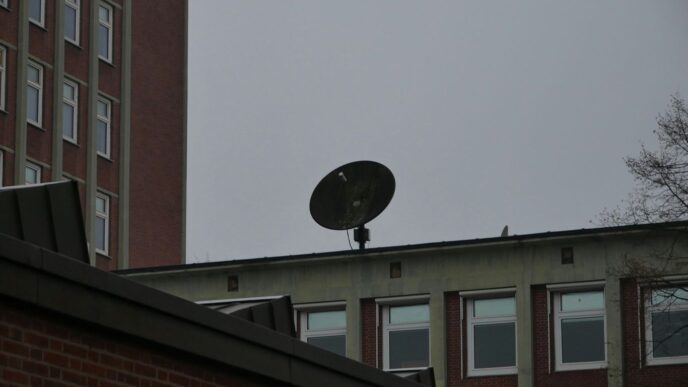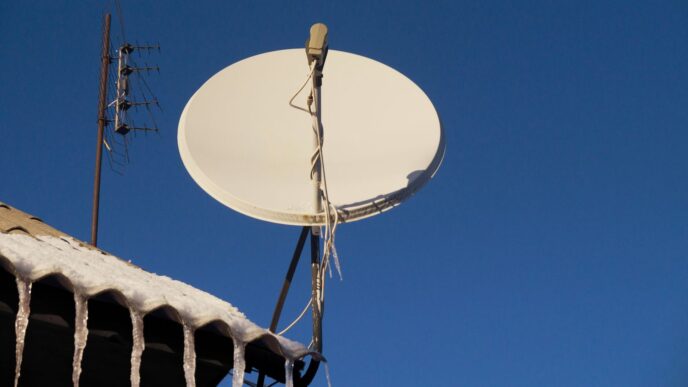Finding the right cell phone company can feel like a puzzle. With so many options out there, from the big names like Verizon and AT&T to smaller players like Google Fi and Mint Mobile, it’s easy to get overwhelmed. We’re breaking down the best cell phone companies in the US for 2025, looking at everything from coverage and pricing to customer service and extra perks. Whether you’re after unlimited data, a budget-friendly plan, or just solid service in your area, this guide should help you figure out what works best for you.
Key Takeaways
- Major carriers like Verizon, AT&T, and T-Mobile offer extensive networks, but numerous MVNOs and prepaid carriers provide cheaper alternatives by using these same networks.
- When choosing a provider, consider your specific location’s coverage, as service quality can vary greatly between carriers in different areas.
- Many smaller carriers don’t sell phones, so you might need to buy an unlocked phone that’s compatible with your chosen provider’s network.
- 5G connectivity is becoming standard, but pay attention to plan details, as some carriers may limit speeds or data for 5G access.
- Customer service quality can differ significantly between providers; research this aspect if it’s a priority for you, with options like Consumer Cellular and Google Fi often scoring well.
1. Verizon Plans
Alright, let’s talk Verizon. When you’re looking at cell phone plans, Verizon has a few main unlimited options, and honestly, the names can be a little confusing. They’ve got Unlimited Welcome, Unlimited Plus, and Unlimited Ultimate. Think of Welcome as the basic package, Plus as the middle ground, and Ultimate as the all-out, top-tier choice.
The Unlimited Welcome plan is the most budget-friendly, but it comes with some limitations. You won’t get access to Verizon’s super-fast 5G Ultra Wideband network, and there’s no hotspot data included. Plus, your regular data speeds might get slowed down if you’re in a really crowded area, like a concert or a big game. It’s pretty solid for everyday use, though, especially if you’re not constantly streaming huge files or need to share your connection. For one line, it’s about $65 a month, and for four lines, you’re looking at $120, assuming you set up auto-pay and paperless billing. If you want extras like the Disney Bundle or Apple One, you can add those on for an extra $10 each per month.
If you need more juice, the Unlimited Plus plan bumps things up. You get access to that faster 5G network, plus 30GB of high-speed hotspot data. This is a good step up if you find yourself needing to share your connection or wanting those quicker download speeds. It’s a bit pricier than Welcome, but you get more for your money.
Here’s a quick look at what you might get:
- Unlimited Welcome: Basic unlimited data, no hotspot, slower 5G access. Good for everyday use.
- Unlimited Plus: Faster 5G access, 30GB of high-speed hotspot data. Better for power users.
- Unlimited Ultimate: This is the top plan, offering the most perks and highest data allowances, though it’s the most expensive.
One cool thing Verizon lets you do is "mix and match" plans. This means if you have multiple lines, one person could be on the Ultimate plan while another is on the Welcome plan. It’s a smart way to save money if everyone in your household has different needs. Just remember, Verizon’s website can make the pricing look a bit complicated, so pay attention to the details. If you’re trying to figure out the best way to get wireless service, this guide might help sort things out.
2. AT&T Coverage
When it comes to cell phone coverage, AT&T is a big player in the US. They’ve been around for a while and have a pretty solid network, especially if you’re in a populated area. Their 4G LTE network is generally reliable across the country.
AT&T’s network is one of the three major ones, meaning a lot of smaller carriers, known as MVNOs, actually use AT&T’s towers to provide their own service. So, if you’re looking at a smaller provider, it’s worth checking if they run on AT&T’s network if that’s what you’re after.
Here’s a quick look at what AT&T offers regarding coverage:
- Extensive 4G LTE: You’ll find good 4G LTE service in most cities and towns, and even in many rural spots.
- Growing 5G Network: AT&T is actively expanding its 5G footprint. While it might not be everywhere yet, it’s getting better all the time, especially in major metropolitan areas.
- International Options: If you travel abroad, AT&T often has decent international plans, though these can add to your bill.
It’s always a good idea to check their coverage maps for your specific address. You can even try out their network with a free trial if you’re curious before committing to a plan. You can explore interactive maps to check AT&T cellular coverage in your specific location. For on-the-go comparisons, download the free Coverage Map app, available for both iPhone and Android devices. Check AT&T coverage before you sign up.
3. T-Mobile Network
T-Mobile has really been making moves in the US cell phone market, and honestly, it’s hard to ignore them these days. They’ve been pouring a lot of resources into expanding their 5G coverage, and it shows. For many people, especially in urban and suburban areas, T-Mobile offers a really solid connection.
They’ve got a few different tiers of 5G, and while the fastest speeds are usually reserved for their main customers, even their more budget-friendly options, like those from Metro, often provide a good experience. If you’re looking at plans from MVNOs that use T-Mobile’s network, like Mint Mobile or Google Fi, you’re generally getting access to a pretty robust infrastructure. It’s worth checking out T-Mobile’s 5G coverage maps to see how it stacks up in your specific neck of the woods.
Here’s a quick look at what T-Mobile generally offers:
- Nationwide 5G: They’ve been aggressive in rolling this out, aiming to cover most populated areas.
- Ultra Capacity 5G: This is their faster 5G band, which offers speeds that can rival home internet in some spots.
- Extended Range 5G: This band uses lower frequencies, giving you better coverage over a wider area, though speeds might not be as blazing fast as Ultra Capacity.
It’s not just about the raw network, either. T-Mobile has also been known for offering some pretty attractive plans and perks, especially if you’re looking for unlimited data or are willing to pay annually. They’ve definitely shaken things up, and it’s a good thing for consumers because it means more choices and often better deals across the board.
4. Google Fi

Google Fi is a bit of a different player in the cell phone game. Instead of having its own towers, it uses T-Mobile’s network here in the US. This means you generally get pretty solid coverage, especially if you’re in an area where T-Mobile is strong. What’s cool about Google Fi is how it handles multiple lines. If you’ve got a family or a group of friends you want to put on the same plan, the price per person drops significantly the more lines you add. It’s a nice way to save some cash if you’re coordinating with others.
They have a couple of main plan types:
- Unlimited Plus: This one is pretty straightforward. You get unlimited data, and it includes a decent chunk of high-speed data before speeds might slow down. It’s a good option if you’re always on your phone, streaming, or downloading stuff. Plus, it’s got some international benefits, which is a nice bonus if you travel.
- Simply Unlimited: This plan is a bit more basic. It still gives you unlimited talk and text, but the data situation is different. You get a set amount of high-speed data, and after that, speeds get slower. It’s usually cheaper than the Unlimited Plus, so it’s worth considering if you don’t burn through data like crazy.
One thing people often mention is that Google Fi is pretty good when it comes to customer service. If you run into issues, they’re generally considered helpful. Plus, if you’re looking for a phone that works with most carriers, Google Fi is a solid choice, especially if you’re eyeing a newer Pixel or iPhone. It’s a flexible option that works well for individuals and families alike. If you’re interested in their unlimited plans, you can check out the details for the Unlimited Plus plan.
5. Consumer Cellular
Consumer Cellular is a solid choice, especially if you’re looking for a provider that really focuses on its customers. They’ve built a reputation for being super helpful, and honestly, that’s a big deal when you’re dealing with phone plans. Many users report saving a good chunk of money compared to their old carriers.
They use the AT&T network, which means you’re generally going to get pretty good coverage across the country. It’s not always the cheapest option out there, but the value comes in the service and reliability. Their most basic plan, for instance, gives you unlimited talk, text, and 1GB of data for around $20 a month. It’s a straightforward approach that works well for people who don’t need a ton of data.
Here’s a quick look at what they offer:
- Plans: Simple, easy-to-understand options with varying data amounts.
- Network: Leverages AT&T’s extensive network for reliable service.
- Customer Service: Consistently praised for being friendly and effective.
- Target Audience: Often a favorite for seniors, but suitable for anyone valuing good support.
If you’re tired of confusing plans and want a provider that feels more personal, Consumer Cellular is definitely worth a look. You can check out their current plans to see if they fit your needs.
6. Mint Mobile
Mint Mobile is a pretty popular choice if you’re trying to save some cash on your phone bill. They operate on T-Mobile’s network, which is good because T-Mobile has a pretty solid coverage map these days. The main thing to know about Mint is that they really push you to buy in bulk. You can get a decent introductory deal, like 5GB of data for $15 a month, but that’s only for the first three months. After that, if you want to keep that low price, you’ve got to pay for a whole year upfront. It’s a big chunk of change to hand over all at once, but if you can swing it, the yearly rate is quite a bit cheaper than paying month-to-month.
They also have an "unlimited" plan, which is $30 a month if you pay for the year. Just remember, "unlimited" usually has a catch. After you use a certain amount of data (around 35GB for Mint), your speeds get slowed down. It’s not the end of the world, but it’s not truly unlimited high-speed data.
One of the things people seem to like about Mint is their customer service. It’s not always perfect, like with any company, but it generally gets good reviews, which is a nice bonus when you’re dealing with a smaller carrier.
Here’s a quick look at their typical pricing structure:
- 5GB Plan: Around $15/month (paid annually after intro period)
- 15GB Plan: Around $20/month (paid annually after intro period)
- Unlimited Plan: Around $30/month (paid annually after intro period)
So, if you don’t mind paying for a year at a time and your phone usage fits one of their data tiers, Mint Mobile can be a really smart way to go.
7. Visible
Visible is a bit of a different player in the cell phone game. They’re an all-digital carrier, meaning you do pretty much everything online or through their app – from signing up to getting help. This makes it super convenient if you’re not into visiting a store.
They run on Verizon’s network, which is a big plus for coverage in a lot of places. What really sets Visible apart is their pricing structure. They tend to have straightforward, all-inclusive plans. You won’t find a million different tiers to choose from, which can be a relief for some people.
Here’s a look at what they generally offer:
- Visible Base: This is their most basic plan. It usually includes unlimited talk, text, and data. The data speeds might be a bit slower than their premium plan, and there could be limits on international use or hotspot data.
- Visible Plus: This plan typically bumps up the data speeds and often includes more international calling and texting options. You’ll also usually get a more generous amount of high-speed mobile hotspot data.
One of the cool things Visible does is offer discounts for bringing friends or for paying for multiple months upfront. It’s their way of trying to keep customers around. Because it’s all online, customer service is usually handled through chat or email, which works well for some but might not be ideal if you prefer talking to someone on the phone. They’re a solid choice if you want simple, affordable service on a strong network and don’t mind managing things digitally.
8. Metro
Metro, formerly MetroPCS, is a prepaid carrier that operates on T-Mobile’s network. It’s a solid choice if you’re looking for a straightforward plan without a lot of bells and whistles, and you want to take advantage of T-Mobile’s 5G coverage. They often bundle taxes and fees into their advertised prices, which is a nice touch that helps avoid those surprise charges that pop up on your bill.
Metro offers a few different unlimited plans, which is pretty convenient. You can get a single line with unlimited talk, text, and data for around $40 a month, though speeds might slow down after you use a certain amount of data, usually around 35GB. They also have options for multiple lines, which can be a good deal if your whole family needs service. For example, four lines might run you about $120 per month with autopay.
Here’s a quick look at what you might expect:
- Unlimited Data: While advertised as unlimited, speeds can be reduced after hitting a data threshold (typically 35GB).
- 5G Access: You get access to T-Mobile’s 5G network, which is pretty widespread in many areas.
- Included Taxes & Fees: This is a big one – what you see advertised is usually what you pay.
- Bundled Plans: Options for multiple lines can make it more affordable for families.
It’s worth checking out Metro by T-Mobile if you’re in an area with good T-Mobile reception and want a no-fuss, budget-friendly plan. Just remember that when the network gets busy, T-Mobile customers might get priority over Metro users, but for most people, this isn’t a major issue.
9. Tello
Tello is one of those smaller carriers that really makes you think about what you actually need from your phone plan. They operate on T-Mobile’s network, which is pretty solid these days, so you’re generally getting good coverage without paying the big bucks.
What’s cool about Tello is that you can build your own plan. It’s not just picking from a few pre-set options. You can choose how much data you want, from a tiny bit up to unlimited, and then add unlimited talk and text. This is great because you’re not paying for stuff you’ll never use. For example, you can get a plan with unlimited calls and texts plus 1GB of data for just $9 a month. If you need a bit more data, 2GB will run you $10. It’s a really budget-friendly way to stay connected.
They also have a $25 plan that gives you unlimited everything – talk, text, and data. Now, the fine print is that after you use 35GB of data, your speeds will slow down quite a bit. But honestly, for most people, 35GB is a ton of data. It’s a good option if you’re not looking to commit to a whole year of service upfront, which some other carriers make you do.
Here’s a quick look at some of their popular plan structures:
- Customizable Plans: Mix and match data amounts with unlimited talk and text.
- Unlimited Plan: Around $25/month for unlimited talk, text, and 35GB of high-speed data before throttling.
- Hotspot Data: Tello does offer hotspot data, which is a nice bonus if you need to connect other devices.
Overall, Tello is a smart choice if you want flexibility and don’t want to overspend. It’s a no-frills approach that works well for many people.
10. US Mobile
US Mobile is a bit of a hidden gem in the cell phone world, especially if you’re looking for a solid plan without breaking the bank. They operate as a mobile virtual network operator (MVNO), meaning they use the networks of the big carriers – Verizon and T-Mobile – to provide their service. This is great because you often get access to really good coverage without paying the premium price.
One of the things that stands out about US Mobile is their flexibility. They have a few different plan structures, but they really shine when it comes to their unlimited options. For instance, you can snag an unlimited talk, text, and data plan for around $25 a month. This plan typically includes a generous amount of high-speed data, often around 35GB, before speeds might slow down. It’s a pretty sweet deal if you use your phone a lot for streaming or browsing.
Here’s a quick look at what you might find:
- Unlimited Starter Plan: Usually offers a good chunk of premium data (like 35GB) for a low monthly cost. It’s a great starting point if you’re unsure about your data needs.
- Unlimited Premium Plan: This often bumps up the premium data allowance and might include perks like a higher hotspot data limit.
- Customizable Plans: If unlimited isn’t your jam, US Mobile also lets you build your own plan based on how many talk, text, and data minutes you actually need. This can be super cost-effective for lighter users.
Something to keep in mind is that some of their best deals, like the $17.50 per month plan with 10GB of data, require an annual payment. So, while the monthly cost looks amazing, you do need to pay for the whole year upfront. It’s a commitment, but if you’re happy with the service, it’s a fantastic way to save money long-term. They also offer a decent amount of hotspot data on their unlimited plans, which is handy if you need to connect other devices on the go. Overall, US Mobile is definitely worth checking out if you want good value and reliable service on major networks.
11. Red Pocket
Red Pocket is one of those carriers that lets you pick which of the big three networks (Verizon, AT&T, or T-Mobile) you want to use. This is pretty handy because you can choose the one that actually has the best signal where you live. They’re a Mobile Virtual Network Operator, or MVNO, which basically means they rent out space on the big guys’ towers.
They have a few different plans, but one that stands out is their $10 monthly option. For that price, you get unlimited talk and text, plus 1GB of high-speed data. It’s not a ton of data, but if you’re not a heavy internet user on your phone, it could be enough. Plus, taxes and fees are usually included, which is a nice change from some other plans where those costs can sneak up on you.
Here’s a quick look at what they offer:
- Basic Plan: Around $10/month for unlimited talk, text, and 1GB of data.
- Network Choice: You can pick between Verizon, AT&T, or T-Mobile.
- Flexibility: They often have various plans available, so it’s worth checking their site for current deals.
It’s a solid choice if you’re looking for a super affordable plan and want to make sure you’re on the best network available in your area. They don’t have a huge number of physical stores, so most of your customer service will likely be online or over the phone, which is pretty typical for these smaller carriers.
12. Unreal
Unreal Mobile is a bit of a newer player in the US mobile market, aiming to offer something different. They operate as a Mobile Virtual Network Operator (MVNO), meaning they don’t own their own cell towers but instead lease network access from one of the major carriers. This allows them to offer plans at potentially lower prices.
Their main selling point seems to be a focus on flexibility and affordability, especially for those who don’t need a ton of data or want to pay for features they won’t use. They often have plans that are quite customizable, which can be a good thing if you know exactly what you’re looking for. However, because they are an MVNO, their coverage will depend entirely on the network they are using at any given time. It’s always a good idea to check coverage maps for the underlying network in your area before signing up.
Here’s a quick look at what they generally offer:
- Data Options: They usually have a range of plans, from very limited data to more generous amounts, often with options for unlimited talk and text.
- Pricing: Generally positioned as a budget-friendly option, with prices that can be quite competitive, especially if you’re looking for basic service.
- Network: As mentioned, they use a major carrier’s network. You’ll want to verify which one and check its reliability where you live and work.
It’s worth noting that with smaller carriers like Unreal, customer service can sometimes be a bit different than with the big three. You might find more online self-service options or potentially longer wait times if you need to speak to someone directly. If you’re someone who likes to tinker with your plan and wants to keep costs down, Unreal Mobile could be worth a look, but do your homework on the network coverage first.
13. TextNow
TextNow is a bit of an outlier in the cell phone world because it offers a completely free plan. Yeah, you read that right. You can get unlimited talk and text without paying a monthly fee. It sounds too good to be true, and there’s a catch, of course. To make this free service work, you have to put up with ads that pop up within the TextNow app itself. It’s how they make their money, so if you don’t mind a few ads, this could be a way to save some serious cash.
To get started, you’ll need to buy an activation kit, which includes a SIM card. This is a one-time, upfront cost, usually around $4.99. After that, your monthly service for calls and texts is free, as long as you can tolerate the ads. It’s important to note that this plan doesn’t include any mobile data. So, if you need internet access on the go, you’ll have to rely on Wi-Fi.
Here’s a quick rundown of what TextNow offers:
- Free Unlimited Talk & Text: The main draw is getting unlimited calling and texting without a monthly bill.
- Ad-Supported Model: To keep the service free, you’ll see ads within the TextNow application.
- No Mobile Data: This plan is strictly for calls and texts; you won’t get any cellular data.
- Upfront SIM Card Cost: There’s a small, one-time fee for the activation kit and SIM card.
TextNow uses Wi-Fi calling and texting primarily, but it also has access to a cellular network for when Wi-Fi isn’t available. It’s a pretty neat option if your phone usage is mostly calls and texts and you’re often connected to Wi-Fi. Just don’t expect to stream videos or browse the web extensively without Wi-Fi.
14. Unlocked Phones
When you’re looking at cell phone plans, especially from the smaller carriers or MVNOs, you’ll often find that they don’t sell phones, or if they do, it’s a very limited selection. This is where unlocked phones come in handy. An unlocked phone isn’t tied to a specific carrier’s network, meaning you can switch providers without needing a new phone.
This gives you a lot more freedom to shop around for the best deals. You can buy a phone outright from a manufacturer like Apple or Samsung, or even pick one up from a retailer, and then just pop in a SIM card from whichever carrier you choose. It’s a pretty straightforward process.
If you’re eyeing plans from companies like Google Fi, Mint Mobile, or Tello, it’s a good idea to make sure your phone is unlocked. Most unlocked phones will work with AT&T and T-Mobile networks, which is great because many MVNOs use those networks. If you want a phone that’s pretty much guaranteed to work on all three major US networks (Verizon, AT&T, and T-Mobile), you might want to look at recent factory-unlocked iPhones (like the 13 series or newer), Samsung Galaxy S models (S22 or newer), Google Pixel phones (Pixel 6 or newer), or some of the newer Moto G phones. It just makes life easier when you’re not locked into one provider’s hardware.
Here’s a quick rundown of what to consider:
- Compatibility: Always double-check that the specific phone model you’re interested in is compatible with the carrier’s network you plan to use, especially with 5G.
- Cost Savings: Buying an unlocked phone upfront can sometimes be cheaper in the long run than paying off a device through a carrier plan, especially if you find a good deal.
- Flexibility: The biggest perk is being able to switch carriers whenever you want, whether it’s for a better price, better coverage in your area, or a plan with more features.
15. 5G Connectivity
So, 5G. It’s the latest and greatest in cell phone speeds, promising faster downloads, smoother streaming, and all that jazz. But here’s the thing: not all 5G is created equal, and how you experience it really depends on your carrier. Your phone might work great on one network’s 5G but be stuck in the slow lane on another. This is a big deal, especially if you’re thinking about switching providers. Before you sign up for a plan, it’s smart to check what kind of 5G your phone supports and what the carrier actually offers.
Most smaller carriers, the MVNOs, do offer 5G plans, but you’ve got to read the fine print. Sometimes they limit you to a specific type of 5G (like sub-6GHz), cap your speeds, or even put a limit on your data, even if the plan says "unlimited." For example, Visible is a solid choice if you want affordable 5G on Verizon’s network. For around $45 a month, you get unlimited talk, text, and data, plus hotspot use. You get a good chunk of high-speed data before speeds might drop. If your phone can connect to Verizon’s 5G Ultra Wideband, that data is actually unlimited.
Metro, which uses T-Mobile’s network, is another good pick. Their unlimited plans with 5G access are usually around $40 a month, though speeds can slow down after a certain amount of data. It’s a decent deal if you’re in an area with good T-Mobile 5G coverage. Even if T-Mobile prioritizes its own customers during busy times, it might not make a huge difference if you’ve already got a strong 5G signal.
If you’re not worried about unlimited data and just want a reliable 5G connection on T-Mobile’s network without breaking the bank, Mint Mobile has a plan for about $15 a month that includes 5GB of data. You do have to pay for the whole year upfront, but it comes with unlimited talk and text. It’s worth looking into if you don’t use a ton of data. Remember to check out T-Mobile’s network for their 5G offerings.
Here’s a quick rundown of what to look for:
- Network Type: Carriers use different 5G bands. Some are faster but have less coverage (like mmWave), while others are slower but cover more ground (like sub-6GHz).
- Speed Caps: Some plans might limit how fast your 5G can actually go, even if the network is capable of more.
- Data Throttling: Be aware of when your data speeds might decrease, especially after hitting a certain usage threshold on "unlimited" plans.
- Hotspot Data: If you plan to use your phone as a Wi-Fi hotspot, check how much high-speed data is included for that purpose.
Verizon, for instance, has different tiers of 5G. To get on their fastest network, called "Ultra Wideband," you usually need to be on one of their more expensive plans. This is different from AT&T and T-Mobile, who generally don’t split access to their fastest 5G based on plan price. So, if you want the absolute quickest speeds from Verizon, you might have to pay a bit more. They also offer more hotspot data on their higher-tier plans, which is nice if you use your phone to connect other devices. It’s a good idea to look at coverage maps for each carrier to see what 5G availability looks like in your area.
16. MVNOs
So, you’re probably wondering what an MVNO is. It stands for Mobile Virtual Network Operator, and basically, they’re smaller cell phone companies that don’t own their own cell towers. Instead, they lease network access from the big guys like Verizon, AT&T, and T-Mobile. Think of it like renting an apartment in a big building instead of owning the whole building yourself. This setup lets them offer plans that are often way cheaper than what you’d get directly from the major carriers.
The main draw of MVNOs is their affordability. Because they don’t have the massive infrastructure costs of building and maintaining cell towers, they can pass those savings onto you. You can find plans with all the basics – talk, text, and data – for a fraction of the price. It’s a smart way to get connected without breaking the bank.
However, it’s not always a perfect picture. Since MVNOs rely on the networks of the big three, their service quality is tied to that network’s coverage in your area. If AT&T has spotty service where you live, an MVNO using AT&T will likely have the same issues. Also, customer service can sometimes be a bit of a mixed bag. You might not get the same level of support as you would with a major carrier, and often, you’ll be dealing with them online or over the phone, as many MVNOs don’t have physical stores.
Here’s a quick look at how some MVNOs stack up:
- Google Fi: Uses T-Mobile’s network primarily, known for its flexible plans and international features.
- Consumer Cellular: Uses AT&T’s network, often praised for its customer service, especially for seniors.
- Mint Mobile: Also uses T-Mobile’s network, offering good value, especially if you pay for service annually.
- Visible: Backed by Verizon, it offers unlimited data and hotspot access at a competitive price.
- Tello: Operates on T-Mobile’s network, providing customizable plans that can be very budget-friendly.
When choosing an MVNO, it’s super important to check which network they use and then look at that network’s coverage map for your usual spots. Also, think about what kind of customer service you need. If you’re someone who likes to walk into a store to sort things out, an MVNO might not be the best fit. But if saving money is your top priority and you’re comfortable handling things online or over the phone, an MVNO could be your ticket to a much cheaper cell phone bill.
17. Prepaid Carriers
When you’re looking to save some cash on your cell phone bill, prepaid carriers are definitely worth a look. They’re a bit different from the big guys like Verizon or AT&T because you usually pay upfront for your service, often month-to-month, without getting locked into a long contract. This means more flexibility, which is pretty sweet.
The biggest draw for prepaid plans is usually the cost savings. You can often find plans that are significantly cheaper than postpaid options, especially if you don’t need a ton of data or the latest and greatest phone. It’s a great way to manage your budget.
Here’s a quick rundown of what to expect:
- No Long-Term Contracts: You pay for service in advance, so you can switch carriers whenever you want without worrying about early termination fees. This is a huge plus if you move around a lot or aren’t sure about a carrier’s service in your area.
- Budget-Friendly Options: Many prepaid carriers offer plans that are well under $50 a month, sometimes even under $20, especially if you’re okay with limited data. This makes them ideal for folks who don’t use their phone for much more than calls and texts.
- Network Access: Most prepaid carriers operate as Mobile Virtual Network Operators (MVNOs). This means they lease network access from the major carriers (AT&T, T-Mobile, and Verizon). So, while you’re paying less, you’re often still getting service on a major network. It’s smart to check which network a prepaid carrier uses to make sure you’ll have good coverage where you live and work. For example, AT&T’s network is known for its strong performance, and prepaid customers can benefit from that solid coverage.
- Customer Service Varies: Because these companies often don’t have physical stores, customer support is usually handled online or over the phone. While some, like Consumer Cellular, get high marks for service, others might be a bit more challenging to deal with if you run into a problem.
Choosing a prepaid carrier means you’re taking more control over your spending and your service. It’s a straightforward approach to staying connected without breaking the bank.
18. Customer Service
When you’re picking a cell phone company, the shiny plan details and coverage maps are important, sure, but what happens when things go wrong? That’s where customer service really shines, or sometimes, completely fizzles out. It’s easy to overlook until you’re stuck on hold for ages, getting bounced between departments, or dealing with someone who clearly doesn’t know how to help.
Think about it: you’ve got a billing question, your phone’s acting up, or you need help understanding a new feature. The last thing you want is a frustrating experience. The best companies in 2025 are really stepping up their game here. They’re not just relying on basic phone lines anymore. We’re seeing a big push towards what they call ‘omnichannel’ support. This means you can reach out through chat, email, social media, or even text, and the company should ideally have your history ready, no matter how you contact them.
Here’s what makes a good customer service experience stand out:
- Quick Response Times: Nobody likes waiting. Whether it’s a live chat popping up quickly or a callback within a reasonable timeframe, speed matters.
- Knowledgeable Agents: This is a big one. You want to talk to someone who actually knows the ins and outs of the service and can solve your problem without making you repeat yourself a dozen times.
- Multiple Contact Options: As mentioned, having choices like live chat, email, and phone support means you can pick what works best for you.
- Problem Resolution: Ultimately, they need to fix your issue. It sounds simple, but so many companies fail here, leaving customers feeling unheard.
Some companies are even using smarter tech, like AI chatbots, to handle simple questions instantly, freeing up human agents for the trickier stuff. It’s a balancing act, though. The goal is to make getting help as painless as possible, not just another chore.
When comparing providers, don’t just look at the price tag. Spend a little time researching how they handle customer issues. Check out online reviews, see what their wait times are reported to be, and if possible, try reaching out with a simple question before you commit. It could save you a lot of headaches down the line.
19. Pricing
When you’re looking at cell phone plans, the price tag is usually the first thing that catches your eye, right? It’s not just about the monthly bill, though. You’ve got to consider what you’re actually getting for your money. Some companies make it super simple, others… not so much. Verizon, for instance, can make figuring out their pricing a bit of a puzzle on their website. They’ve got different tiers and add-ons that can really change the final cost.
Here’s a general idea of how pricing can shake out:
- Major Carriers (Verizon, AT&T, T-Mobile): These guys often have higher base prices, but they might throw in extra perks like streaming service bundles or more hotspot data. You’re paying for the big network and those extras.
- MVNOs (Mobile Virtual Network Operators): Think Mint Mobile, Google Fi, or US Mobile. These companies usually lease network access from the big three, which lets them offer much lower prices. They often focus on specific needs, like unlimited data or a set amount of data per month.
- Budget Carriers (Consumer Cellular, Metro): These are often geared towards specific demographics or offer simpler, no-frills plans that are easy on the wallet.
The cheapest plans often come with less data, so if you’re a heavy internet user on your phone, you’ll want to check those data caps carefully. Some plans might look cheap upfront but can get expensive if you go over your data limit or need extra features like international calling. It’s always a good idea to compare a few options side-by-side to see what fits your budget and your usage habits best. Don’t forget to look out for deals on annual payments, which can sometimes shave off a good chunk of the cost.
20. Perks
When you’re picking out a cell phone plan, it’s easy to get caught up in just the monthly price and data limits. But don’t forget about the extras – the perks! These can really add up and make a big difference in the overall value you get.
Think about what you actually use. Some carriers bundle in streaming services like the Disney Bundle or Apple One. While these might cost extra on the cheaper plans, they can be included with the pricier ones. It’s worth checking if you’d pay more for these services separately anyway. For example, Verizon offers these as add-ons for about $10 a month each, so if a plan includes one, you’re already saving a bit.
Another common perk is hotspot data. If you often need to get your laptop or tablet online when you’re away from Wi-Fi, having a decent amount of high-speed hotspot data included can be a lifesaver. Some plans offer a generous 30GB or even 60GB, while others give you none at all on their most basic tiers. It’s a feature that really separates the budget plans from the more premium ones.
Beyond streaming and data, carriers sometimes throw in other benefits. This can include things like discounts on new phones, especially if you’re willing to sign up for a longer contract or a higher-tier plan. Some companies also offer special deals for specific groups, like military and first responders. It’s always a good idea to see if you qualify for any of these.
Here’s a quick look at what some carriers might offer:
- Streaming Service Bundles: Disney Bundle, Apple One, etc.
- Hotspot Data: Varying amounts of high-speed mobile hotspot data.
- Device Discounts: Special offers on new phone purchases or trade-ins.
- Group Discounts: Savings for military, teachers, nurses, and other professions.
- International Benefits: Perks for using your phone abroad.
Ultimately, the best perks are the ones that align with how you use your phone. Don’t pay extra for a perk you’ll never use, but definitely consider the value if it’s something you’ll take advantage of regularly.
21. Coverage Maps

When you’re picking a cell phone company, looking at coverage maps is a big deal. It’s basically a way to see where you’re likely to get a signal and where you might run into dead zones. These maps are your best bet for figuring out if a carrier actually works where you live, work, and travel.
Think of it like this: even if a company says they have "nationwide" coverage, that doesn’t mean you’ll have bars everywhere. The big three – Verizon, AT&T, and T-Mobile – all have pretty good coverage across the US, especially with their 4G LTE and 5G networks. But there are still differences, and what’s great in one town might be spotty in the next.
Here’s what you should keep in mind when you’re checking out those maps:
- Check your specific locations: Don’t just look at the whole country. Zoom in on your home, your workplace, and any other places you go often. That’s where you need reliable service.
- Understand the map key: Coverage maps usually have different colors or shades to show signal strength. Green might mean a strong signal, while yellow or red could mean weaker service or even no service.
- Consider 5G vs. 4G LTE: Most maps will show both. 5G is faster, but its range can be more limited than 4G LTE. If you’re in an area with only 4G LTE, make sure that signal is strong.
- MVNOs use the big networks: If you’re looking at a smaller carrier (an MVNO), remember they don’t have their own towers. They rent space on Verizon, AT&T, or T-Mobile’s networks. So, check which network the MVNO uses and look at that network’s coverage map.
Some carriers, like T-Mobile with its Network Pass, or Verizon and AT&T with their trial options, even let you test their service for a bit before you commit. That’s a great way to see how their coverage actually performs in your daily life, beyond what the map suggests.
22. Hotspot Data
So, you need to get your laptop online when you’re out and about, huh? That’s where hotspot data, or tethering, comes in. It basically turns your phone into a Wi-Fi hotspot, letting other devices connect to the internet through your phone’s cellular signal. It’s super handy, but not all plans treat it the same way.
Some plans give you a decent chunk of high-speed hotspot data, while others might limit it or even charge extra. Verizon, for instance, often puts more hotspot data on its pricier plans, like their Unlimited Plus. You might get 30GB of high-speed hotspot data there, which is pretty good for getting work done on the go. On the flip side, some budget-friendly options might only offer a smaller amount, say 5GB or 10GB, or they might slow down your hotspot speeds significantly after you hit a certain limit.
Here’s a quick look at how some plans handle it:
- Verizon Unlimited Plus: Often includes a good amount of high-speed hotspot data (e.g., 30GB).
- Visible: Known for offering unlimited hotspot data, though sometimes at slower speeds after a certain threshold.
- US Mobile: Might offer a plan with a set amount of hotspot data, like 20GB, which is a good middle ground if you don’t need unlimited.
- Tello: You can find plans with specific data allowances for hotspot use, or sometimes it’s included with their general data.
When you’re picking a plan, definitely check the fine print on the hotspot data. How much high-speed data you get for tethering can make a big difference in your daily usability. If you plan on using your phone as a hotspot regularly, especially for more than just quick email checks, look for plans that offer a generous amount of high-speed data for it. Otherwise, you might find yourself running out of fast internet sooner than you think.
23. Trade-In Offers
Thinking about upgrading your phone? Most carriers and even some MVNOs offer trade-in deals, which can really cut down the cost of a new device. It’s basically like getting a discount on your next phone by giving them your old one.
The value you get depends a lot on the phone you’re trading in and the phone you’re buying. Newer, high-end phones usually get you the most credit. Sometimes, carriers will even offer bonus trade-in values, especially when a new model just dropped.
Here’s a general idea of how it works:
- Check Eligibility: Make sure your old phone is in good condition – no cracked screens or water damage usually. Some places might accept damaged phones, but you’ll get less money.
- Get a Quote: Most companies have online tools where you can enter your current phone model and see how much it’s worth.
- Apply the Credit: The trade-in value is often applied as a monthly credit on your new phone bill over a set period, like 24 or 36 months. Sometimes, you might get a lump sum or an instant discount.
- Consider the Fine Print: Always read the details. Are there specific plans you need to be on to get the full offer? Does the credit apply to the phone itself or your monthly service?
It’s worth comparing offers from different providers. What one company offers for your old phone might be significantly different from another. Don’t just assume you’ll get the best deal with your current carrier; sometimes switching can lead to better trade-in incentives.
24. Unlimited Plans
Okay, so you’re looking for an unlimited plan. It sounds simple, right? Unlimited talk, text, and data. But in the US cell phone world, "unlimited" can mean a whole lot of different things, and the price tags can jump around quite a bit.
The big carriers, like Verizon, AT&T, and T-Mobile, all have their own versions of unlimited, and they’re not all created equal. Sometimes, the "unlimited" part only applies to a certain amount of high-speed data, like maybe 30GB or 50GB. After you hit that limit, your speeds can slow down to a crawl, which is super annoying if you’re trying to stream a video or download something important.
Verizon, for example, has a few tiers. You’ve got your basic "Unlimited Welcome," which is the cheapest. It gets you unlimited data, but you won’t get access to their fastest 5G speeds, and forget about any hotspot data. Then there’s "Unlimited Plus." This one bumps you up to faster 5G and gives you a decent chunk of high-speed hotspot data – 30GB, I think. If you want the absolute best, "Unlimited Ultimate" is the top dog, offering even more hotspot data and international perks, but it comes with a hefty price tag. The cool thing Verizon does is let you "mix and match" plans for different lines on your account. So, maybe one person in the family needs the super-fast 5G and hotspot, but everyone else is fine with the basic plan. You can set that up.
But it’s not just the big guys. MVNOs, those smaller carriers that use the big networks, often have some really good unlimited deals. Companies like Tello, Mint Mobile, and Visible are worth checking out. Tello, for instance, offers unlimited everything for around $25 a month on T-Mobile’s network, though again, speeds get slower after a certain data amount. Mint Mobile is similar, usually around $30 a month, but you often have to pay for a year upfront, which is a big commitment. Visible is another popular one, offering unlimited data and even unlimited hotspot data for $25 a month. US Mobile also has an unlimited plan for $25, but their hotspot data is capped at 20GB, so you gotta watch that.
Here’s a quick look at what some of these might offer:
- Tello: Unlimited talk, text, and data (speeds slow after 35GB) – around $25/month.
- Mint Mobile: Unlimited talk, text, and data (speeds slow after 35GB) – around $30/month (often requires annual payment).
- Visible: Unlimited talk, text, and data, plus unlimited hotspot data – around $25/month.
- US Mobile: Unlimited talk, text, and data (20GB hotspot limit) – around $25/month.
When you’re picking an unlimited plan, think about:
- How much high-speed data do you really need? Most people don’t burn through 100GB a month, but if you do, you need to check those limits.
- What about hotspot data? If you use your phone as a Wi-Fi hotspot for your laptop or other devices, make sure the plan includes enough high-speed data for that.
- Do you need international perks? Some premium plans include calling or data in other countries, which can save you a lot if you travel.
- Are you okay with paying for a whole year upfront? Some of the best deals, like Mint Mobile’s, require this. It’s a big chunk of change at once.
So yeah, "unlimited" is a starting point, but you’ve got to read the fine print to make sure you’re actually getting what you need without paying for stuff you don’t.
25. Annual Payments and more
When you’re looking at cell phone plans, don’t just check the monthly price. Some companies really push you to pay for a whole year upfront. It sounds like a lot of money all at once, but it can actually save you a good chunk over time. Think of it like buying in bulk – you get a better deal.
For example, carriers like Mint Mobile and US Mobile often have their best rates tied to annual payments. You might see a plan advertised for $15 a month, but that usually means you have to pay for 12 months at once, which could be around $180. It’s a big payment, but if you break it down, you’re saving compared to paying month-to-month.
Here’s a quick look at how some plans shake out with annual payments:
- Mint Mobile: Offers a $15/month rate for unlimited talk, text, and 5GB of data, but this requires a 12-month upfront payment ($180 total).
- US Mobile: You can get 10GB of 5G data with unlimited talk and text for about $17.50 per month, also paid annually.
- Unreal Mobile: Their $20/month plan for unlimited talk, text, and 5GB of data at full speed is a three-month plan, but you can often find better deals if you commit to a longer term, sometimes paid annually.
Beyond just annual payments, keep an eye out for other ways to save. Many companies offer discounts if you set up automatic payments and go paperless with your billing. Verizon, for instance, knocks $10 off per line per month if you do both. It might seem small, but that adds up over a year. Also, check for specific discounts if you’re a student, military member, nurse, or first responder. Sometimes these can shave off a significant amount from your monthly bill.
So, What’s the Verdict?
Alright, so picking a cell phone company in 2025 really comes down to what you need and what you’re willing to spend. We’ve looked at the big names like AT&T, T-Mobile, and Verizon, but also a bunch of smaller companies, often called MVNOs, that can save you some serious cash. Remember to check which network they use, because even if a company is cheaper, you still want good service where you live and work. Don’t forget about your phone, too – make sure it’ll actually work with the plan you pick, especially if you’re hoping to use 5G. It might seem like a lot to sort through, but by thinking about coverage, price, and any extras you care about, you can find a plan that fits you just right. Happy hunting!
Frequently Asked Questions
What’s the difference between big phone companies and smaller ones?
Big companies like Verizon, AT&T, and T-Mobile have their own cell towers all over the country. Smaller companies, called MVNOs, rent space on these big networks. This often means smaller companies can offer cheaper plans because they don’t have to build and maintain all the towers themselves. Think of it like renting an apartment in a big building instead of buying and building your own house.
How do I know which phone company has the best signal where I live?
The best way to check is to look at the coverage maps on each company’s website. You can also ask friends or family who live near you what company they use and if they like the signal. Some companies even let you try out their service for free for a short time before you commit to a plan.
What does ‘unlimited data’ really mean?
While many plans say ‘unlimited data,’ it usually means you get a certain amount of super-fast data each month. After you use that up, your internet speed might slow down for the rest of the month. Some plans might also slow down your speed if the network is very busy.
Can I use my current phone with a cheaper plan?
Usually, yes! Many cheaper plans work with unlocked phones. An unlocked phone isn’t tied to one specific company. Before you switch, it’s a good idea to check with the new company to make sure your phone will work with their network. Some newer phones work best with specific networks for the fastest speeds.
Are there phone plans that don’t cost a lot each month?
Definitely! Many companies offer plans for $10 to $30 per month. These plans might have less data or fewer extras, but they can be a great way to save money if you don’t use your phone for a lot of heavy internet stuff or need the absolute fastest speeds all the time.
What is 5G, and do I need it?
5G is the latest type of mobile internet connection, and it’s much faster than older types like 4G. While it’s not essential for everyone, it makes things like streaming videos and downloading files much quicker. Many newer phones can use 5G, but you’ll need a plan that supports it to get those faster speeds.














